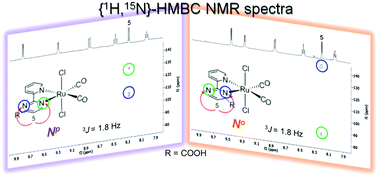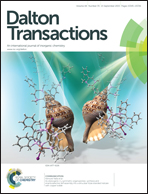15N NMR spectroscopy unambiguously establishes the coordination mode of the diimine linker 2-(2′-pyridyl)pyrimidine-4-carboxylic acid (cppH) in Ru(ii) complexes†
Abstract
We investigated the reactivity of three Ru(II) precursors – trans,cis,cis-[RuCl2(CO)2(dmso-O)2], cis,fac-[RuCl2(dmso-O)(dmso-S)3], and trans-[RuCl2(dmso-S)4] – towards the diimine linker 2-(2′-pyridyl)pyrimidine-4-carboxylic acid (cppH) or its parent compound 4-methyl-2-(2′-pyridyl)pyrimidine ligand (mpp), in which a methyl group replaces the carboxylic group on the pyrimidine ring. In principle, both cppH and mpp can originate linkage isomers, depending on how the pyrimidine ring binds to ruthenium through the nitrogen atom ortho (No) or para (Np) to the group in position 4. The principal aim of this work was to establish a spectroscopic fingerprint for distinguishing the coordination mode of cppH/mpp also in the absence of an X-ray structural characterization. By virtue of the new complexes described here, together with the others previously reported by us, we successfully recorded {1H,15N}-HMBC NMR spectra at natural abundance of the 15N isotope on a consistent number of fully characterized Ru(II)–cppH/mpp compounds, most of them being stereoisomers and/or linkage isomers. Thus, we found that 15N NMR chemical shifts unambiguously establish the binding mode of cppH and mpp – either through No or Np – and can be conveniently applied also in the absence of the X-ray structure. In fact, coordination of cppH to Ru(II) induces a marked upfield shift for the resonance of the N atoms directly bound to the metal, with coordination induced shifts (CIS) ranging from ca. −45 to −75 ppm, depending on the complex, whereas the unbound N atom resonates at a frequency similar to that of the free ligand. Similar results were found for the complexes of mpp. This work confirmed our previous finding that cppH has no binding preference, whereas mpp binds exclusively through Np. Interestingly, the two cppH linkage isomers trans,cis-[RuCl2(CO)2(cppH-κNp)] (5) and trans,cis-[RuCl2(CO)2(cppH-κNo)] (6) were easily obtained in pure form by exploiting their different solubility properties.


 Please wait while we load your content...
Please wait while we load your content...